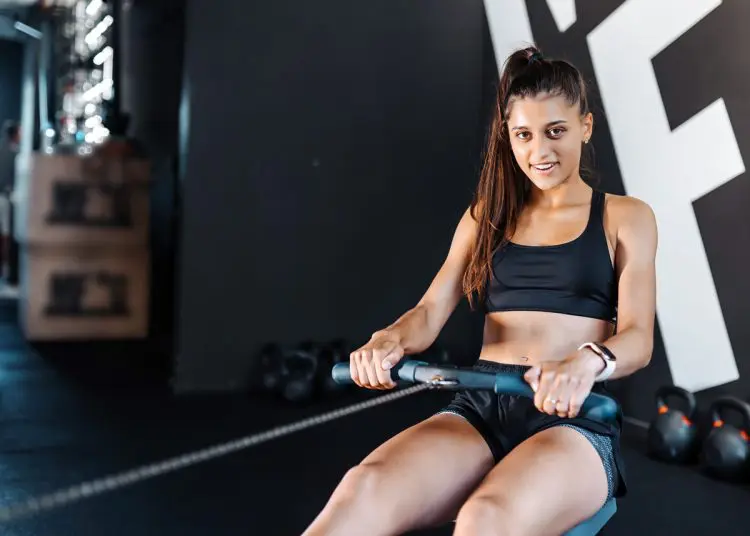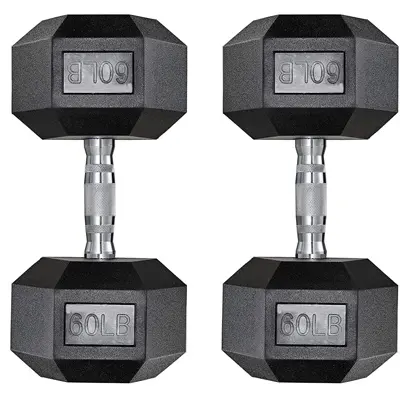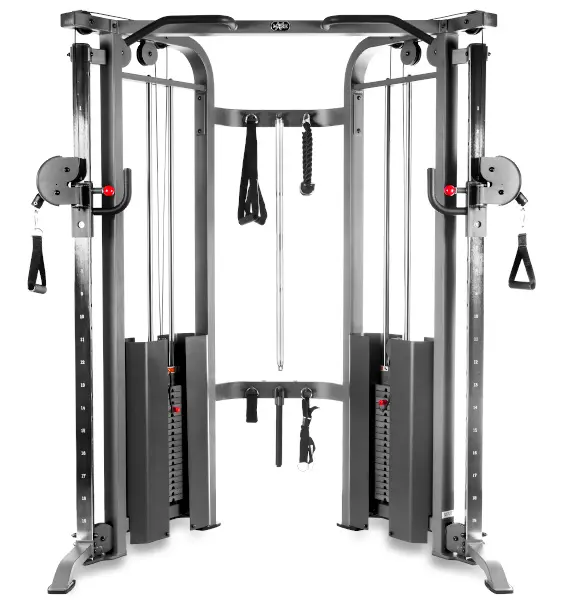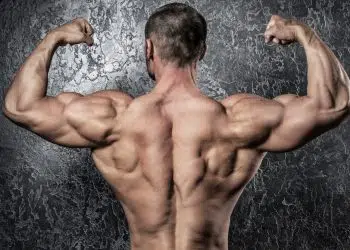Most newbie lifters gravitate toward free weight training, aiming for quick results.
Free weights are undoubtedly among the most effective options for serious muscle-building. Since this equipment doesn’t have a fixed line of pull like machines, your secondary muscles must engage to keep the weights stable and balanced while you lift.
The result: More growth due to higher muscle recruitment.
But not all gym machines are built equal. In fact, one machine may even deliver a better workout than free weights. That’s right, I’m talking about the cable machine!
As a veteran personal trainer with over a decade of experience helping people transform their physiques, I can attest that cables are among the most effective training equipment you can use.
In this article, I reveal the 15 best cable exercises to transform your back and achieve the coveted V-taper aesthetic.
Level Up Your Fitness: Join our 💪 strong community in Fitness Volt Newsletter. Get daily inspiration, expert-backed workouts, nutrition tips, the latest in strength sports, and the support you need to reach your goals. Subscribe for free!
Recent Updates: On July 9, 2024, Fitness Volt’s Content Strategist Tom Miller (CSCS) and Senior Editor Vidur Saini (American Council on Exercise-CPT) updated the article and added actionable expert tips throughout the piece to improve the reader experience.
Best 15 Cable Back Exercises:
- Wide-Grip Lat Pulldown
- Close-Grip Lat Pulldown
- Reverse-Grip Lat Pulldown
- Seated Cable Rows
- Full Extension Seated Cable Rows
- Face Pull
- Straight-Arm Pulldown
- One-Arm Seated Cable Rows
- Split Stance Low Cable Row
- Kneeling Cable Crossover Lat Pulldown
- Single-Arm Lat Pulldown
- Cable Lying Pullover Extension
- Incline Cable Row
- Cable Rear Delt Fly
- Cable Shrug
1. Wide-Grip Lat Pulldown
| Sets & Reps | 3 x 8-12 |
| Equipment Needed | Lat pulldown machine |
| Target Muscles | Latissimus dorsi, teres major, rhomboids, posterior deltoids |
Let’s start with the best of the best: the Wide-Grip Lat Pulldown.
What makes this the best? Simple: it’s as close to a Pull-Up as you can get, meaning it’s the best exercise to help train all the muscles involved in Pull-Ups. Pull-Ups are a pretty standard metric to measure fitness and functional strength, so they definitely deserve a place in your weekly training sessions.
If you’re not capable of doing a lot of Pull-Ups (and, let’s be honest, many of us are still struggling to knock out a complete set), Wide-Grip Lat Pulldowns give you the same exact workout, but instead of pulling your body weight up toward the bar, you pull the bar down toward your body.
The Wide Grip focuses on your lats, but also gives your posterior deltoids, traps, and rhomboids an amazing workout. It also encourages better upper back breadth. This should be the “opener”, the first exercise you do and with the most weight you can handle. Spending more time on this exercise will help you develop the strength needed to improve your Pull-Up performance.

How to do it:
- Attach a wide grip bar to the lat pulldown machine.
- Grasp the bar with a wide, overhand grip.
- Sit down facing the cable machine, with your legs secured under the thigh pad and your feet flat on the floor.
- Pull the shoulder blades back and down and maintain a neutral spine.
- Pull the bar down until it touches your chest.
- Pause at the bottom of the movement, then slowly return to the starting position.
- Repeat for the desired number of repetitions.
Pro Tip: Avoid shrugging your shoulders during the movement.
Benefits:
- It’s an excellent back exercise that is easy to learn and beginner-friendly.
- Mimics the benefits of bodyweight pull-ups.
- Promotes good postures and spinal stability.
| Difficulty | Progression | Regression |
| Beginner | Increase weight, use a wider grip | Assisted lat pulldown machine, negative reps |
2. Close-Grip Lat Pulldown
| Sets & Reps | 3 x 8-12 |
| Equipment Needed | Lat pulldown machine (V-bar or close-grip attachment) |
| Target Muscles | Latissimus dorsi, biceps brachii, teres major |
Shifting your hands closer together for the Close-Grip Lat Pulldown changes the angle of the exercise, moving the focus toward the upper lats and building better overall upper back strength. It’s a bit harder on your wrists, but it increases the range of motion for your elbows.
For the Close Grip, your hands should be narrower than shoulder-width apart, but if the angle is too painful on your wrists (for those recovering from wrist strains or sprains), you can slide them slightly outward to shoulder width.
Your core muscles will do more work here because you’ll be pulling the weight downward across the anterior (front) plane of your body. But going through the full motion of pulling the bar down to your chest and slowly raising it back up to “resting” position will put some serious tension on your upper back muscles and build excellent strength.
How to do it:
- Grasp the bar with a narrow, overhand grip.
- Sit down facing the cable machine, with your legs secured under the thigh pad with your feet flat on the floor.
- Pull the shoulder blades back and down and maintain a neutral spine.
- Pull the bar down until the elbows are in line with your torso.
- Slowly return to the starting position.
- Repeat for the desired number of repetitions.
Pro Tip: Do not let the momentum dictate the movement. Maintain an upright torso throughout the movement.
Benefits:
- Allows a better range of motion.
- Provides better stretch to the lats.
| Difficulty | Progression | Regression |
| Intermediate | Paused reps | Assisted lat pull-downs |
3. Reverse-Grip Lat Pulldown
| Sets & Reps | 3 x 8-12 |
| Equipment Needed | Lat pulldown machine (straight bar) |
| Target Muscles | Latissimus dorsi, biceps brachii |
Reversing your grip changes it from “Pull-Up Grip” to “Chin-Up” grip. There is a greater focus on the biceps with this grip, which is good if you’re trying to develop better arm and shoulder strength in tandem with upper back strength. However, if the goal is to primarily focus on your upper back, the regular Wide Grip Lat Pulldowns reign supreme.
Reversing your grip also shifts the focus to your lower lats, and there is greater core engagement (similar to close grip lat pulldowns). You’ll have to make a conscious effort to keep your shoulders back and down, and to avoid using your momentum to pull the bar down. The more isolated and controlled the movement, the better!
How to do it:
- Grasp the bar with a narrow, underhand grip.
- Sit down facing the cable machine, with your legs secured under the thigh pad with your feet flat on the floor.
- Pull the shoulder blades back and down and maintain a neutral spine.
- Pull the bar down, keeping the elbows close to the body.
- Slowly return to the starting position.
- Repeat for the desired number of repetitions.
Pro Tip: Use the EZ bar attachment to get your wrist in a more comfortable position.
Benefits:
- It helps you focus more on the lat development.
- Bicep engagement is slightly higher compared to other variations.
| Difficulty | Progression | Regression |
| Intermediate | Wide-grip variation | Conventional lat pulldown |
4. Seated Cable Rows
| Sets & Reps | 3 x 8-12 |
| Equipment Needed | Cable machine (V-bar or straight bar attachment) |
| Target Muscles | Latissimus dorsi, rhomboids, trapezius, posterior deltoids, biceps brachii |
Seated Cable Rows are excellent for anyone who wants to develop strength used for rowing—rowing machines, rowing boats, kayaks, canoes, etc. Instead of it being an “up and down pull”, it’s a “front and back pull” with the tension coming from directly in front of you rather than overhead.
Seated Cable Rows target your upper back, along with your mid-back and traps. Using different bars and handles can change the focus of the exercise—i.e., a wide-grip bar can build breadth, while a close-grip Double-D handle will build strength along the spinal column.
This exercise engages your lower back more, which can be excellent if you’re trying to develop better core strength, but a negative if you’re recovering from lower back injuries. To reduce lower back strain, keep your upper body strictly motionless and use only your arms, shoulders, and back muscles to pull the cable with every repetition.

How to do it:
- Attach the close grip handle to the machine and set the desired weight.
- Grab the handles with a neutral grip and get seated with your feet resting on the footpad.
- Keep the neutral spine, shoulders retracted back, and knees slightly bent.
- Pull the handle towards your belly button, and squeeze the contraction for a second before slowly returning to starting position.
- Repeat for the desired number of reps.
Pro Tip: Keep the core tight and engaged throughout the movement.
Benefits:
- An excellent isolation exercise to add size and thickness to the back.
- The seated row is easy to learn.
- Strengthens the horizontal pulls.
| Difficulty | Progression | Regression |
| Beginner | Tempo sets | Single-arm cable row |
Read more: How To Do Seated Cable Row
5. Full Extension Seated Cable Rows
| Sets & Reps | 3 x 8-12 |
| Equipment Needed | Cable machine (straight bar or rope attachment) |
| Target Muscles | Latissimus dorsi, erector spinae, rhomboids, trapezius |
This is an excellent variation of the Seated Cable Row, one that places even more focus on the mid-back, particularly the lower lats, and rhomboids.
With this movement, instead of isolating your torso, you allow your body to lean forward slightly as you return to “resting” position, and actually let your shoulders slide forward to full extension. This forces your back to engage earlier in the movement, and it concentrates the initial movement on your rhomboids for more effective targeting.
However, if you have lower back issues or are recovering from an injury in your shoulders, it’s better to avoid this exercise due to the higher range of motion—which gives more chances for injury.
How to do it:
- Attach the straight bar to the machine and set the desired weight.
- Grab the bar with an overhand grip and get seated with your feet resting on the footpad.
- Keep the neutral spine, shoulders retracted back, and knees slightly bent.
- Pull the handle towards your torso and squeeze the contraction for a second.
- Slowly lean forward as you return to the starting position.
- Repeat for the desired number of reps.
Pro Tip: Keep your chest up and lower-back arched throughout the row.
Benefits:
- Enhances the range of motion, resulting in more significant muscle hypertrophy.
- Boosts the lat engagement.
| Difficulty | Progression | Regression |
| Beginner | Slow down the eccentric phase | Seated cable row without full extension |
6. Face Pull
| Sets & Reps | 3 x 12-15 |
| Equipment Needed | Cable machine (rope attachment) |
| Target Muscles | Rear deltoids, rhomboids, middle trapezius |
The Face Pull is an excellent exercise to perform standing, thereby reducing the strain on your lower back. It also does an amazing job of highlighting the upper lats, traps, posterior deltoids, and rhomboids. It’s even effective to help you strengthen your rotator cuff muscles, but it’s much safer than Upright Barbell Rows because it only travels through one plane of motion (forward and backward) without straining the shoulder joint.
With the Face Pull, the cable machine is set to your eye level, and you use the rope handle to allow for greater range of motion. As you pull the handle toward you, your hands separate and pull to either side of your head.
There is amazing tension on your shoulders and upper back muscles at the end of this concentric pulling phase, and the tension is continuous during the eccentric phase as you return your hands to their starting position. The result is greater definition in all the back and shoulder muscles involved in the movement!
How to do it:
- Set the cable machine about chest height, and use rope attachment.
- Grab the rope with an underhand grip with your thumbs backward.
- Keep your arm straight, core braced, and shoulders retracted.
- Pull the rope towards your face.
- Squeeze the contraction for a second before slowly returning to the starting position.
- Repeat for the desired number of reps.
Pro Tip: Avoid grabbing the cable with an overhand grip, as it increases the internal rotation of the shoulders.
Benefits:
- Boosts posture and shoulder health.
- Face pull strengthens the rotator cuff muscles to provide added stability to the upper back.
- Reduces the risk of injury, especially in the shoulder and neck region.
| Difficulty | Progression | Regression |
| Beginner | Half-kneeling face pulls | Banded face pull |
7. Straight-Arm Pulldown
| Sets & Reps | 3 x 10-15 |
| Equipment Needed | Cable machine (straight bar attachment) |
| Target Muscles | Latissimus dorsi |
This is an interesting isolation exercise that helps you to develop better upper back strength across a broader range of motion than most other pull exercises. Instead of recruiting the arms or shoulders, it’s entirely focused on your lats.
With the Straight-Arm Pulldown, your arms are at full extension, you’re bent slightly forward at the waist, and your upper back muscles do all the work of pulling the weight down across the front of your body. It’s an exercise you definitely want to start light with, so you can focus on the specific, controlled movement, then slowly work your way up to heavier weights once you’re comfortable with the isolation.
How to do it:
- Slide the cable pulley to the highest notch on the machine and attach a double-sided rope.
- Grip the rope with both hands and stand facing the pulley with feet about shoulder-width apart. Take a step back if you need to.
- With your arms extended straight out in front of you, back straight, lats tight, shoulders back, and chest up, drive your elbows down and back. Pull the handles away from each other and move your hands past your sides.
- Allow your arms to slowly return to the starting position and repeat.
Pro Tip: Using rope attachment will allow better lat engagement by allowing a superior range of motion.
Benefits:
- It’s an excellent lat isolation exercise.
- It’s a great accessory movement that boosts the training volume.
- It can be incorporated into the back warmup routine.
| Difficulty | Progression | Regression |
| Intermediate | Dumbbell pullover | Conventional lat-pulldown |
8. One-Arm Seated Cable Rows
| Sets & Reps | 3 x 8-12 (per arm) |
| Equipment Needed | Cable machine (single handle attachment) |
| Target Muscles | Latissimus dorsi, rhomboids, trapezius, posterior deltoids, biceps brachii |
Any “one-arm” exercise increases engagement of all the core muscles (obliques, abs, and spinal erectors) in order to improve core strength and stability. This exercise isn’t ideal for those recovering from lower back injuries, but can be highly effective to help you build lower back and core strength to reduce injury risk down the road.
With the One-Arm Seated Cable Row, the form is the same as the Seated Cable Row, except that you’re gripping a D-handle in one hand rather than a wide-grip bar in two hands. To double down on the core-focused aspect of the workout, twist your torso slightly as you pull the weight to your abdomen. This trunk rotation will target the obliques, abs, and back, helping to strengthen these vital stabilizer muscles.
With the One-Arm Seated Cable Row, you can identify which of your arms is the stronger (it’s not always the dominant side), making it easier for you to give the weaker arm greater priority in your training.
How to do it:
- Attach the single handle to the cable and set the desired weight.
- Grab the handle with one hand and get seated with your feet resting on the footpad.
- Extend your arm fully, and stay upright. Keeping the spine neutral and knees slightly bent.
- Pull the handle towards your torso, keeping the elbow close to your body.
- Slowly return the handle back to starting position.
- Repeat for the desired number of reps before you switch sides.
Pro Tip: Keep the core tight and engaged.
Level Up Your Fitness: Join our 💪 strong community in Fitness Volt Newsletter. Get daily inspiration, expert-backed workouts, nutrition tips, the latest in strength sports, and the support you need to reach your goals. Subscribe for free!
Benefits:
- Strengthens the core by improving anti-rotational force.
- Corrects strength and muscle imbalances.
| Difficulty | Progression | Regression |
| Intermediate | T-bar row | Two-arm seated cable row |
9. Split Stance Low Cable Row
| Sets & Reps | 3 x 8-12 (per side) |
| Equipment Needed | Cable machine (single handle attachment) |
| Target Muscles | Latissimus dorsi, rhomboids, trapezius, posterior deltoids, gluteus medius (of the rear leg) |
Some also call it a ‘Lawnmower Row’ because it looks like pulling a starter handle of a gas-powered lawnmower. This exercise will turn your boring traditional cable rows into a full-body functional movement.
Using the low cable machine works on the upper back muscles, including the rear delts, trapezius, rhomboids, and teres major. Furthermore, split stance low cable row also improves athleticism by engaging the core, glutes, and hamstring — providing more bang for the buck.
How to do it:
- Attach a D-shaped handle to a low cable machine.
- Hold the handle and step back into a staggered stance for stability.
- Brace your abs and pull your shoulders down and back.
- Pull the cable up and back to your ribs, leading with your elbow.
- Lower the weight back to the starting position.
- Repeat for the desired number of reps before your switch sides.
Pro Tip: Slight torso rotation will increase your range of motion.
Benefits:
- It’s a unilateral back exercise that addresses muscle imbalances.
- Enhances core and hip stability.
| Difficulty | Progression | Regression |
| Intermediate | Seated cable row | Double-arm variation |
10. Kneeling Cable Crossover Lat Pulldown
| Sets & Reps | 3 x 8-12 |
| Equipment Needed | Cable machine (two single-handle attachments) |
| Target Muscles | Latissimus dorsi, teres major |
Kneeling cable crossover lat pulldown is an excellent variation to train your back for width. Unlike the traditional lat pulldown, you will require the cable crossover station.
What’s so special about this exercise? The cable crossover machine allows you to perform the lat pulldown with a wider grip, focusing more on the upper lats and teres major. Having strong and well-developed teres major can significantly influence the width of your back.
Plus, both hands move independently, allowing you to work on muscle symmetry. The freedom of movement of two separate pulleys improves the mind-muscle connection and helps you squeeze and contract those lats far better.
How to do it:
- Set the cable machine pulleys to the highest setting and attach a D-handle to each cable.
- Grasp each handle with an overhand grip and kneel down with your arms extended straight up towards the pulleys.
- Keep your back straight and core engaged.
- Retract the shoulder blades and pull the handles down, bringing elbows close to the torso.
- Pause for a movement before you slowly return to the starting position.
- Repeat for the desired number of repetitions.
Pro Tip: Focus on slow eccentric and fast concentric.
Benefits:
- Excellent back exercise to develop a V-taper.
- Enhances mind-muscle connection.
- Improves symmetry.
| Difficulty | Progression | Regression |
| Intermediate | Slow eccentrics | Assisted lat pulldown, wide-grip lat pulldown |
11. Single-Arm Lat Pulldown
| Sets & Reps | 3 x 8-12 (per arm) |
| Equipment Needed | Cable machine (single handle attachment) |
| Target Muscles | Latissimus dorsi, teres major, rhomboids, posterior deltoids, biceps brachii |
Are you looking to hone in on lats for growth? The single-arm lat pulldown is the variation for you. It’s unilateral that focuses on one side at a time.
Single-arm lat pulldown allows a better range of motion and highlights muscle imbalances.
How to do it:
- Attach the single handle to the lat pulldown machine.
- Grab the handle with one hand and sit down with your legs secured under the thigh pad with your feet flat on the floor.
- Pull the handle down until it gets in line with the shoulders.
- Pause the bottom of the movement, then slowly return the bar to the starting position.
- Repeat for the desired number of repetitions before switching sides.
Pro Tip: Slight lateral flexion of the torso will improve lat contraction.
Benefits:
- It’s a unilateral exercise that fixes strength and muscle imbalances.
- It allows you to alter the grip positioning for high-quality movement.
| Difficulty | Progression | Regression |
| Intermediate | Pull-ups | Two-arm lat pulldown |
12. Cable Lying Pullover Extension
| Sets & Reps | 3 x 8-12 |
| Equipment Needed | Cable machine (straight bar attachment) |
| Target Muscles | Latissimus dorsi, pectoralis major, triceps brachii |
It is a supine variation of a straight-arm pulldown that keeps the spine stable and perfectly positioned. This exercise is especially suitable for those who find it hard to sense the lat engagement during the straight-arm pulldown.
A lying pullover allows excellent stretch in the lats.
How to do it:
- Adjust the cable machine to the lowest setting and attach a rope attachment.
- Lie flat on a bench that is perpendicular to the cable machine.
- Grasp the rope with both hands and start with the arms extended above your chest.
- Slowly bring your hands behind your head, keeping your arms straight.
- Exhale as you return the handle to the starting position (above your chest).
- Repeat for the desired number of reps.
Pro Tip: Keep the core braced and focus on optimal lat stretch.
Benefits:
- Enhances the lat development.
- Prevents cheat reps.
| Difficulty | Progression | Regression |
| Intermediate | Dumbbell pullover | Straight-arm pulldown |
13. Incline Cable Row
| Sets & Reps | 3 x 8-12 |
| Equipment Needed | Cable machine (two single handle attachments), incline bench |
| Target Muscles | Latissimus dorsi, rhomboids, trapezius, posterior deltoids, biceps brachii |
Most of the rowing variations feel really challenging when you are dealing with lower back pain.
The incline cable row allows you to work on the horizontal pulls without taxing the lower back.
Eliminating the role of core stabilization allows you to pay full attention to the back engagement, helping the mind-muscle connection.
How to do it:
- Set the bench at a 45-degree incline, placed perpendicular to the cable station.
- Adjust the cable machine to the lowest setting and attach a rope attachment.
- Lean forward with your chest towards the bench.
- Grab the rope with an overhand grip, and hands shoulder-width apart.
- Retract the shoulder blader and keep the core tight.
- Pull the rope towards your chest, driving through the elbows.
- Squeeze the contraction for a movement before slowly returning to the starting position.
- Repeat for the desired reps.
Pro Tip: Emphasize the full range of motion.
Benefits:
- Excellent exercise to add thickness to the back.
- Prevents lower back pain.
| Difficulty | Progression | Regression |
| Intermediate | Barbell bent-over row | Seated cable row |
14. Cable Rear Delt Fly
| Sets & Reps | 3 x 12-15 |
| Equipment Needed | Cable machine (two single-handle attachments) |
| Target Muscles | Rear deltoids, rhomboids, middle trapezius |
The cable rear delt fly is perhaps the best single-joint exercise to target the upper back and posterior delts (rear). Prominent rear delts play a massive role in creating a back that looks like a mountain range.
Cable rear delt fly also strengthens the horizontal abduction at the shoulder joint, making this exercise quite unique and effective. Apart from training the rear delt, this exercise also strengthens the rhomboids, mid traps, infraspinatus, and supraspinatus muscles.
How to do it:
- Set the cables at shoulder height.
- Stand in the middle of the cable crossover machine.
- Grab the right side cable with the left hand and the left side cable using the right hand.
- Take a step back to get your arms extended at shoulder level, with a slight elbow bend. Palms should be facing down towards the ground.
- Retract the shoulder blades and keep your chest up.
- In a semicircular motion, pull your hands out to your side.
- Slowly return to the starting position.
- Repeat for the desired reps.
Pro Tip: Keep the tempo slow and controlled.
Benefits:
- Targets the whole upper back.
- Improves shoulder stability.
- Addresses the weak links by strengthening the shoulder abduction.
| Difficulty | Progression | Regression |
| Beginner | Tempo reps | Reverse pec deck fly, band pull aparts |
15. Cable Shrug
| Sets & Reps | 3 x 12-15 |
| Equipment Needed | Cable machine (two single-handle attachments) |
| Target Muscles | Upper trapezius, levator scapulae |
Shrugs help you develop massive traps. Well-developed traps not only build a cobra back but also plays a crucial role in your performance during deadlifts, squats, and Olympic lifts.
When there isn’t enough free weight available to do the shrugs, cables are often the best solution. Honestly, cable shrugs feel slightly better when you want a superior mind-muscle connection.
You can perform the cable shrugs with single or double cables. Double cables improve the quality of trap contraction because you will be pulling the weight up and toward the body, both at the same time.
How to do it:
- Adjust the cable machine pulleys to the lowest setting.
- Attach a D-handle attachment to both cables.
- Grasp the handles with both hands and stand middle of the cable crossover with your feet hip-width apart.
- Keep the arms fully extended.
- Raise your shoulders as high as possible towards your ears.
- Hold the contraction for two seconds, then slowly lower your shoulders back down to the starting position.
- Repeat for the desired number of repetitions.
Pro Tip: Focus on using your traps, do not let the arms hijack the movement.
Benefits:
- Helps you develop monstrous traps.
- Improves shoulder stability and corrects posture.
| Difficulty | Progression | Regression |
| Beginner | Pause at peak contraction | Dumbbell shrugs, barbell shrugs |
Sample Cable Back Workouts
As we mentioned above, you can perform a wide range of back exercises using a cable, which allows you to target every back muscle. However, to build an all-around strong and symmetrical back, you need a systematic workout plan.
We have designed two back workouts that require nothing but a cable station. These two workout programs are designed to keep your training interesting, even if you are training your back twice a week.
Workout # 1
| # | Exercise | Sets | Reps | Recovery |
| 1 | Wide grip lat pulldown | 4 | 10-15 | 2 minutes |
| 2 | Reverse grip lat pulldown | 3 | 10-12 | 90 seconds |
| 3 | Straight arm pulldown | 3 | 10-12 | 60 seconds |
| 4 | Seated cable row | 4 | 8-12 | 90 seconds |
| 5 | Split stance low cable row | 3 | 8-12 (each side) | 60 seconds |
| 6 | Cable rear delt fly | 3 | 10-15 | 60 seconds |
| 7 | Calble shrugs | 4 | 8-12 | 60 seconds |
Workout # 2
| # | Exercise | Sets | Reps | Recovery |
| 1 | Incline cable row | 4 | 8-12 | 90 seconds |
| 2 | Full extension seated row | 3 | 10-12 | 90 seconds |
| 3 | Facepull | 3 | 10-12 | 60 seconds |
| 4 | Kneeling cable crossover lat pulldown | 4 | 8-12 | 90 seconds |
| 5 | Close grip lat pulldown | 3 | 8-12 (each side) | 60 seconds |
| 6 | Cable shrugs | 4 | 8-12 | 60 seconds |
Note: Don’t worry about leaving your lower back untrained since it will be working hard to stabilize the majority of the exercises. If you want to add separate lower back strengthening exercises to your workout routine, you can include bird-dog, superman hold, and glute bridges.
Are Cable Machines Better than Free Weights?
Honestly, comparing the cable machine and free weights is like comparing apples and oranges. Both are awesome, and both deliver the desired results, but they have some pretty important differences.
Free Weights Pros and Cons
Free weights are more versatile, and can be used literally anywhere at the gym or at home. You just need a few dumbbells, a barbell with weight discs, or a kettlebell, and you can work out pretty much anywhere.
Free weights are superior to many weight machines because of one key difference; the instability that forces you to engage your secondary muscles to keep the weight stable during any movement. This is advantageous for maximizing muscle, strength, and overall functional fitness, and the strength you develop is more well-rounded.
With free weights, it’s easier to work on muscular imbalances. Simply switch your exercises from a barbell to a dumbbell, with different weights for each hand, and you’ve got a way to train the weaker muscles on your non-dominant side.
Cable Machine Pros and Cons
Probably the biggest “con” of cable machines is that they’re large machines that do not move. Seriously, you’ve got hundreds of pounds combined—between the frame, the weight plates, etc.—so once the cable machine is set up, it’s going nowhere.
Cable machines are also often too pricey for people who want to train at home. Thanks to their popularity, they’re typically the machine most commonly occupied at the gym.
But there’s one crucial factor about cable machines that make them a truly amazing addition to your workout: the continuous muscle tension.
When you perform an exercise using a free weight—let’s use Bicep Curl as an example—the weight provides resistance from the bottom of the movement to the top. You start feeling the weight as you curl the weight upward, and it’s only when you reach the very top of that concentric (curling) phase that your arms get a break.
But with cable machines, there is no break. Even when you’re at the top of that curl, your forearm and bicep muscles are still engaged in order to keep the cable from pulling the bar back down to a resting position. This continuous tension means that a cable workout delivers a fractionally better workout, leading to faster muscle fatigue and greater micro-damage to the muscle fibers that contribute to growth.
If your gym has a cable machine, it’s one of the best options to help you get an amazing workout, no matter what muscle group you’re working.
It’s particularly effective for your back muscles! You’ll find that the versatility of the cable machine makes it an excellent option for a varied upper and lower back workout. Because you can adjust the height and angle of the cable pull, you can hit all of the important upper and lower back muscles in a number of different ways.
Below, we’ve listed our fifteen favorite cable back exercises to help you improve the quality of your workout and benefit from that continuous tension that makes cable machines so effective!
[Related: Best Cable Exercises for Abs]
FAQs
1. How do you get explosive lats?
Training for explosiveness involves improving your ability to generate force quickly and efficiently. Building explosiveness strength is not about the exercise selection but the training tempo. You can develop explosiveness in your lats by including plyometric training, medicine ball throws, and speed drills.
2. Which pulldown is best for lats?
Choose an exercise that maximizes the lat stretch and allows a superior range of motion. Narrow grip lat pulldown variations deliver fantastic stretch to the lats.
Furthermore, unilateral exercises provide better mind-muscle connection and improve your focus on the lengthening and contraction of muscle fibers.
3. Are cable exercises effective?
Cable exercises are as effective as their free-weight counterparts. Cable exercises offer all the main drivers of muscle hypertrophy — great range of motion, freedom of movement, maintaining constant tension on muscle fibers, and progressive overload.
4. How to train back with lower back pain?
Training with low back pain can be pretty tricky. There are a few things that you need to keep in mind: select an exercise that provides torso support and ditch the exercise that requires extensive torso stabilization. Plus, practice lower-back strengthening drills to enhance lower-back strength.
Conclusion
These fifteen awesome exercises will amp up your upper back workout to eleven, and deliver serious results thanks to the continuous tension that makes cable machines so effective. They’re not necessarily a replacement for Pull-Ups or free weight exercises (like Rows, Bent-Over Rows, Dumbbell Rows, and so many others), but can be implemented in your workout as desired to achieve maximum results.
By incorporating the cable machine into your workout, you can enhance muscular strength through both the concentric and eccentric phases of the exercises, and see faster strength and size gains. You’ll love feeling the burn as you train using the exercises we’ve listed above!
Interested in measuring your progress? Check out our strength standards for Dumbbell Pullover, Face Pull, Pull Ups, and more.














